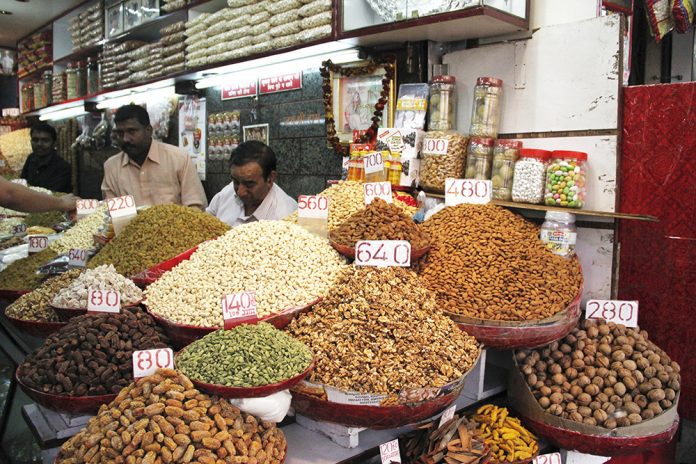
Tree nut industry leaders applauded India’s agreement in June to lift retaliatory tariffs on U.S. walnuts and almonds, with California walnut executives particularly pleased after losing significant market share over the last four years.
“We lost tremendous market share during the time that we have had this 20% retaliatory tariff,” said Pam Graviet, senior director of global programs for the California Walnut Board and Commission. “Being on a level playing field really opens up that opportunity for walnuts from California to become more affordable.”
In almonds, the retaliatory tariff was 6 rupees per kilogram, or roughly 7 cents a kilogram, not nearly as high as in walnuts. But Richard Waycott, CEO of the Almond Board of California, said the industry still welcomed the relief.
“In terms of economic impact per kilo, it’s not that significant,” Waycott said. “But it will be a little cheaper (for importers), and that will follow through to the consumer. So, it’s good news.”
India imposed retaliatory tariffs on walnuts, almonds and other U.S. goods in 2019 in response to tariffs the U.S. imposed on Indian steel and aluminum imports in 2018.
The retaliatory tariffs in walnuts came on top of a 100% tariff India imposed on all walnuts entering the country in May 2018 (up from a previous tariff of 30.9%), a tariff which continues today.
California walnut exports to India subsequently dropped from 16,000 short tons at their peak in the 2016-17 crop year to just under 4,000 short tons last year, Graviet said.

Market Potential
In the meantime, India’s market potential for walnuts has continued to develop, said Robert Verloop, CEO and executive director of the California Walnut Board and Commission.
“If you take a look at the population growth in India over the last decade, and particularly the last five years, they have a younger population base,” Verloop said. “They are becoming more affluent. And they are a plant-based eating culture. The younger generation is also looking for more diversity in their food choices and looking for more international flavors. So, you’ve a lot of things in our favor to expand walnut penetration in various markets, whether it’s the high-density markets of the smaller tier-2, tier-3 or tier-4 markets.”
“We are expecting to see a significant change from where we have been the last couple of years,” Graviet said.
Walnut sales to India, which purchases almost strictly in-shell walnuts and in fact has an industry dedicated to hand cracking the nuts, were on a steady climb over the past decade, Graviet said. Sales peaked as the 10th largest export market for California walnuts in the 2016-17 crop year, and Graviet believes if the retaliatory tariff had not been instituted in 2019, India could now be among the industry’s top export markets.
“If the market hadn’t been constrained by these barriers, looking at the change in Indian demographics and consumption patterns, there was speculation that it would easily have been in our top three,” Graviet said.

The industry has put significant resources into developing the market, particularly through the USDA Market Access Program, Graviet said, and has developed strong trade relations with importers, traders, distributors, processors and retailers. “In spite of the challenges, we have continued to invest in the Indian market through our integrated consumer and trade programs along with educating healthcare professionals about the health benefits of walnuts,” Graviet said.
Verloop added the timing of the tariff reduction couldn’t be better.
“We’re looking at the new crop year coming in here with great crop conditions and sufficient supply,” he said. “So, in many ways, this is a wonderful year to reintroduce ourselves with maximum volumes.”
“The timing is exceptional,” Graviet said.
Plenty of Supply
Almonds, too, have plenty of supply to meet an increase in demand from India, Waycott said.
“The reduction in tariff will be beneficial for Indian demand, and there will be plenty of supply,” Waycott said. “We entered the 2022-23 crop year with the largest inventory that we’ve had as an industry, about double what we normally have.”
Going forward, Waycott said the bigger issue for California almonds in India is getting on even footing with Australia, which in January of this year struck a bilateral trade agreement with India to lower their tariff by 50%.
“So, currently, Indian importers can import Australian almonds at 50% of the duty that they need to pay for U.S. almonds,” Waycott said. India’s current tariff on almond imports from California is 35 rupees per kilogram, compared to 17.5 rupees per kilo for Australian almond imports.

“That is the more significant situation right now for us in that we have the competitive factor there that is putting us at a disadvantage,” Waycott said.
Despite the retaliatory tariff on California almonds, which increased the tariff to 41 rupees per kilogram between 2019 and this year, other than a slight slippage in exports in 2020 and 2021, a slippage induced at least in part by COVID-19, India has been a consistent growth market for California almonds, Waycott said.
“Generally speaking, it’s been a growth market for us, and the tariffs haven’t been debilitating,” Waycott said.
India is by far the largest export market for California almonds, Waycott added, and the industry has invested heavily to support the market.
“The Almond Board of California has been actively involved in India for 25 years, and we’ve had what we call an integrated consumer program there for the past 15 years,” Waycott said. “And today, it’s the largest investment that we make in terms of growing demand and market development outside the U.S.”
He added the industry has yet to notice any direct impact of the January 1 India-Australia bilateral agreement, but he expects it could be significant.
“It’s early days and the Australian crop was quite reduced this year, so it is a little hard to tell,” he said. “But certainly, their exports have increased, and we expect that to be the case until hopefully the American government can negotiate some type of similar agreement [with India].”
Waycott noted the counter-seasonal aspect of Australia’s almond production can help California almonds overcome the economic disadvantage it operates with in India, particularly in fall and winter months as buyers typically prefer to purchase the freshest product possible.
“But, having said that, almonds are very shelf-stable products,” he said. “So, old crop doesn’t become old for a couple of years.”
Other Export Challenges
Perhaps an even bigger issue for almond exports, Waycott said, is the extreme market advantage Australia enjoys over California almonds in China, which imposed a much higher tariff on California almonds in response to U.S. tariffs on not only Chinese steel and aluminum imports, but also on a variety of other goods from China.
Also at play in China is Australia now operates in the Chinese market under a free trade agreement.
“In China, we are currently at 55%, but there is a 30% exemption that Chinese importers can apply for and are being granted,” Waycott said. “That takes our effective tariff down to 25%, but we are still at the disadvantage of a 25% tariff versus Australia, which negotiated a free trade agreement with China about three years ago.”
Waycott said he hoped to see a resolution to the issue soon but as of July had not seen any movement.
“I think the fact that Secretary Blinken and Secretary Yellen have been in the country recently and have been having discussions with Chinese officials is encouraging,” he said. “We have not seen any movement at all yet in the discussions of pulling off those tariffs, but I think the fact that they are talking is a good thing.”











